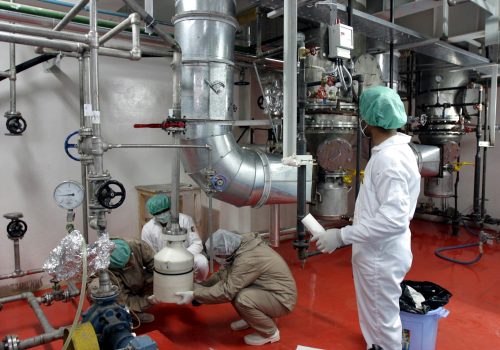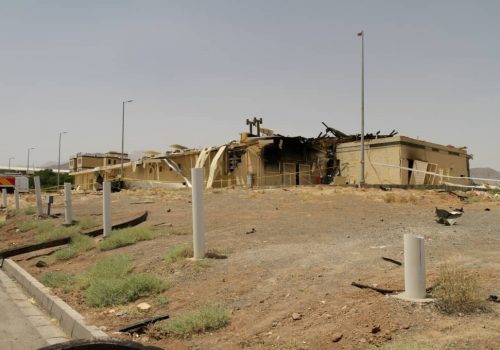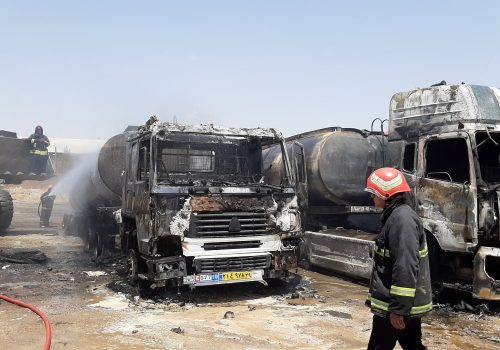Iran’s expansion of uranium stockpile is troubling but manageable
The most recent report by the International Atomic Energy Agency (IAEA) on Iran’s nuclear program demonstrates that the main result of the Trump administration’s “maximum pressure” campaign has been the fraying of US alliances and the steady expansion of Iran’s enriched uranium stockpile.
At the same time, the IAEA report documents Tehran’s relative nuclear restraint and the continued viability of the 2015 Joint Comprehensive Plan of Action (JCPOA), which the US unilaterally withdrew from in 2018.
Secretary of State Mike Pompeo attempted to use Iran’s uranium stockpile growth to push the remaining parties—Britain, France, Germany, China and Russia—away from the agreement, to convince them to “wake up to the reality that the nuclear deal is history,” and to join US sanctions targeting Iran. However, this appeal is likely to fail.
Iran’s expanding uranium stockpile and its other violations of the deal are troubling, but the current risk is manageable and reversible.
The September 4 IAEA report confirms that Iran now possesses about 2,105 kilograms of uranium enriched to less than 4.5 percent, which is roughly ten times the 202 kilogram limit set by the deal (202 kilograms of uranium enriched to 3.67 percent by weight equates to 300 kilograms of uranium gas enriched to the same level). But to put this number in perspective, Iran’s output of enriched uranium has remained fairly steady over the course of 2020, demonstrating that Tehran is not accelerating production.
The IAEA also noted no significant changes in the number of centrifuges enriching uranium or in enrichment levels, which means that the breakout time—the period it would take to produce enough nuclear material for one weapon—remains three to four months—roughly the same as it was in June. This is a significant decrease from the twelve months established by full implementation of the JCPOA, but it’s still enough time for the international community to act if Tehran made the decision to pursue a bomb. As of the September report, it is likely that Iran could produce enough weapons-grade material for a second nuclear device from its current stockpile of enriched uranium, but that would take several additional months.
Iran also continues to test advanced centrifuge machines beyond what is allowed by the deal and is using cascades of those machines to produce enriched uranium, which the JCPOA prohibits. The number of those machines operating as of the September report is similar to what the IAEA reported in June. Iran did notify the agency of its intention to expand installation of advanced machines, but stated that the number of advanced machines enriching uranium would remain constant. This also speaks to a strategy of consistent pressure in response to the US sanctions campaign instead of an effort to destroy the deal or dash to a bomb.
While the knowledge gained by testing and operating these machines cannot be “reversed,” it is unlikely to be a gamechanger. Tehran’s pursuit of so many different advanced centrifuges—fourteen—is less worrisome than if Iran had a clearly designated successor for its inefficient first-generation centrifuges that are currently responsible for nearly all its enrichment. And if the full implementation of the JCPOA is restored under a future US administration, it would create space for a long-term discussion on future limits for Iran’s advanced centrifuge program, among other nuclear issues.
While Iran’s violations of the JCPOA cannot and should not be ignored, the nuclear deal has not been hollowed out completely. The IAEA report confirms that Iran continues to abide by critically important verification measures put in place by the deal, including continuous monitoring of enrichment levels and key sites. As a result, if Tehran were to further move outside the limits set by the JCPOA or make the political decision to dash to a bomb, it is highly likely that its efforts would be quickly detected.
Also, on the positive side of the equation, Iran and the IAEA have resolved a dispute over access to two undeclared sites where the agency has evidence of possible undeclared nuclear material and activities. According to a second September 4 IAEA report, one of the visits has already taken place and a date for inspectors to visit the second location is scheduled for later this month.
While Iran’s stonewalling was concerning and it is critical that the nine-month delay between the request for access and the inspections do not become a precedent, the IAEA made clear that the materials and activities in question pre-date 2003 (when the IAEA assessed Iran had an organized nuclear weapons program) and are not currently ongoing. In this case, though the delay fed speculation that Iran had something to hide, it is unlikely that the results of the investigation will significantly alter the assessment of Iran’s nuclear weapons capabilities acquired from its past program nor argue that they pose a near-term risk. However, Iran must comply with such requests down the road in a more timely fashion.
Just days after the IAEA report was finalized, Ali Salehi, head of the Atomic Energy Organization of Iran, announced that Iran was building a new facility for manufacturing advanced centrifuges in the mountains near Natanz. He described the decision as a direct response to an act of sabotage targeting the current production building in July. It is unclear who was behind the sabotage—Tehran says it has identified the perpetrators of the attack but has not yet named them—but Iran’s response should serve as a reminder that diplomacy is the only option for addressing proliferation risks over the long-term.
Construction of the facility itself does not pose a near-term threat as Iran’s production of centrifuges is subject to continuous surveillance for twenty years under measures put in place by the JCPOA. Given that IAEA reports have consistently noted Tehran’s compliance with the deal’s verification measures, there is no reason to believe this facility, if completed, would be treated any differently.
Nevertheless, Iran’s decision exemplifies the risk and limits of kinetic action intended to disrupt the country’s nuclear program. Targeted acts of sabotage or direct strikes may set back Iran’s program, but they cannot erase the fact that Iran already has the capabilities necessary to build nuclear weapons, something US intelligence agencies concluded in 2007. As evidenced by the Natanz case, destruction of the country’s nuclear facilities are unlikely to push Tehran to abandon its nuclear program and will instead spur Iran to rebuild in locations more difficult to target. If Iran feels its nuclear program is less vulnerable and if it’s concerned about deterring further strikes or sabotage, that could influence any future discussion about the costs versus the benefits of pursuing nuclear weapons.
In the face of failed US efforts to garner support for multilateral Iran sanctions, the Trump administration is likely to redouble its efforts to kill the JCPOA. Despite this, the most recent IAEA reports demonstrate that the window for returning to full implementation of the nuclear deal is still open and, if anything, has widened slightly given progress on the agency’s investigation into possible past undeclared activities. Returning to compliance with the nuclear deal and using it as a platform for a longer-term framework remains the best option to ensure Iran’s nuclear program remains peaceful for decades to come.
Kelsey Davenport is the director for nonproliferation policy at the Arms Control Association.
Image: Head of Iran's Atomic Energy Organization Ali-Akbar Salehi and International Atomic Energy Agency (IAEA) Director General Rafael Grossi, attend a press conference in Tehran, Iran August 25, 2020. WANA (West Asia News Agency) via REUTERS


